1999 DODGE RAM engine
[x] Cancel search: enginePage 973 of 1691
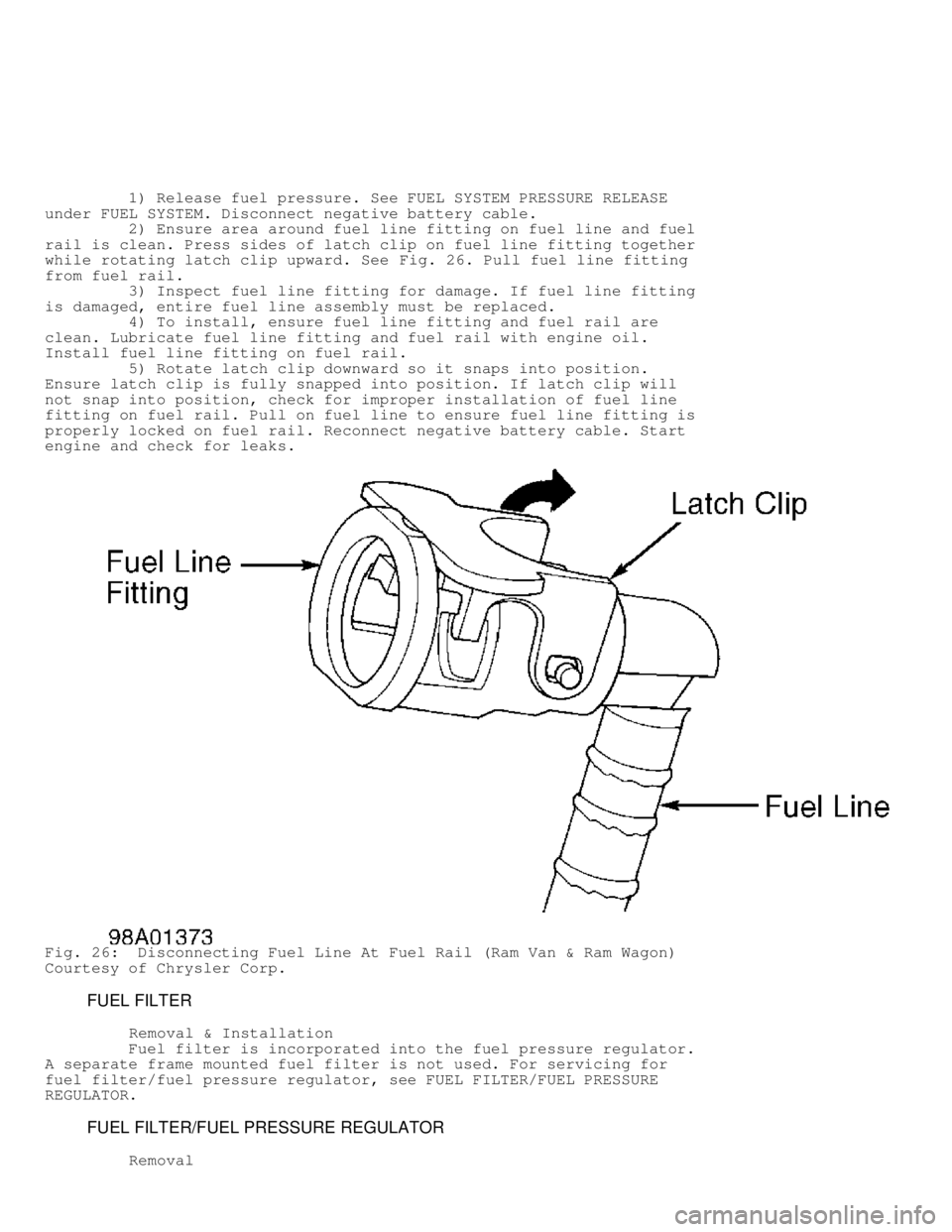
1) Release fuel pressure. See FUEL SYSTEM PRESSURE RELEASE
under FUEL SYSTEM. Disconnect negative battery cable.
2) Ensure area around fuel line fitting on fuel line and fuel
rail is clean. Press sides of latch clip on fuel line fitting together
while rotating latch clip upward. See Fig. 26. Pull fuel line fitting
from fuel rail.
3) Inspect fuel line fitting for damage. If fuel line fitting
is damaged, entire fuel line assembly must be replaced.
4) To install, ensure fuel line fitting and fuel rail are
clean. Lubricate fuel line fitting and fuel rail with engine oil.
Install fuel line fitting on fuel rail.
5) Rotate latch clip downward so it snaps into position.
Ensure latch clip is fully snapped into position. If latch clip will
not snap into position, check for improper installation of fuel line
fitting on fuel rail. Pull on fuel line to ensure fuel line fitting is
properly locked on fuel rail. Reconnect negative battery cable. Start
engine and check for leaks.
Fig. 26: Disconnecting Fuel Line At Fuel Rail (Ram Van & Ram Wagon)
Courtesy of Chrysler Corp.
FUEL FILTER
Removal & Installation
Fuel filter is incorporated into the fuel pressure regulator.
A separate frame mounted fuel filter is not used. For servicing for
fuel filter/fuel pressure regulator, see FUEL FILTER/FUEL PRESSURE
REGULATOR.
FUEL FILTER/FUEL PRESSURE REGULATOR
Removal
Page 980 of 1691
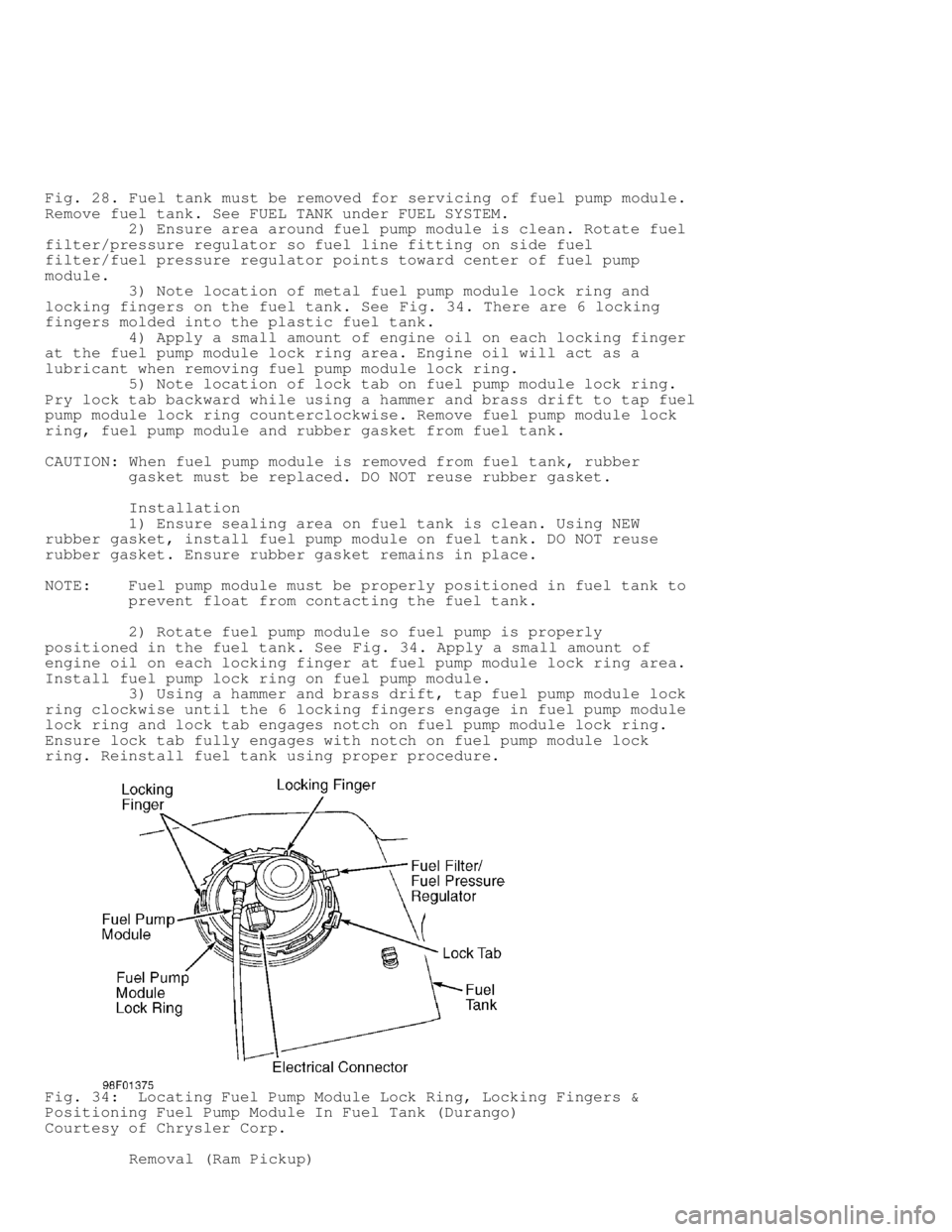
Fig. 28. Fuel tank must be removed for servicing of fuel pump module.
Remove fuel tank. See FUEL TANK under FUEL SYSTEM.
2) Ensure area around fuel pump module is clean. Rotate fuel
filter/pressure regulator so fuel line fitting on side fuel
filter/fuel pressure regulator points toward center of fuel pump
module.
3) Note location of metal fuel pump module lock ring and
locking fingers on the fuel tank. See Fig. 34. There are 6 locking
fingers molded into the plastic fuel tank.
4) Apply a small amount of engine oil on each locking finger
at the fuel pump module lock ring area. Engine oil will act as a
lubricant when removing fuel pump module lock ring.
5) Note location of lock tab on fuel pump module lock ring.
Pry lock tab backward while using a hammer and brass drift to tap fuel
pump module lock ring counterclockwise. Remove fuel pump module lock
ring, fuel pump module and rubber gasket from fuel tank.
CAUTION: When fuel pump module is removed from fuel tank, rubber
gasket must be replaced. DO NOT reuse rubber gasket.
Installation
1) Ensure sealing area on fuel tank is clean. Using NEW
rubber gasket, install fuel pump module on fuel tank. DO NOT reuse
rubber gasket. Ensure rubber gasket remains in place.
NOTE: Fuel pump module must be properly positioned in fuel tank to
prevent float from contacting the fuel tank.
2) Rotate fuel pump module so fuel pump is properly
positioned in the fuel tank. See Fig. 34. Apply a small amount of
engine oil on each locking finger at fuel pump module lock ring area.
Install fuel pump lock ring on fuel pump module.
3) Using a hammer and brass drift, tap fuel pump module lock
ring clockwise until the 6 locking fingers engage in fuel pump module
lock ring and lock tab engages notch on fuel pump module lock ring.
Ensure lock tab fully engages with notch on fuel pump module lock
ring. Reinstall fuel tank using proper procedure.
Fig. 34: Locating Fuel Pump Module Lock Ring, Locking Fingers &
Positioning Fuel Pump Module In Fuel Tank (Durango)
Courtesy of Chrysler Corp.
Removal (Ram Pickup)
Page 982 of 1691
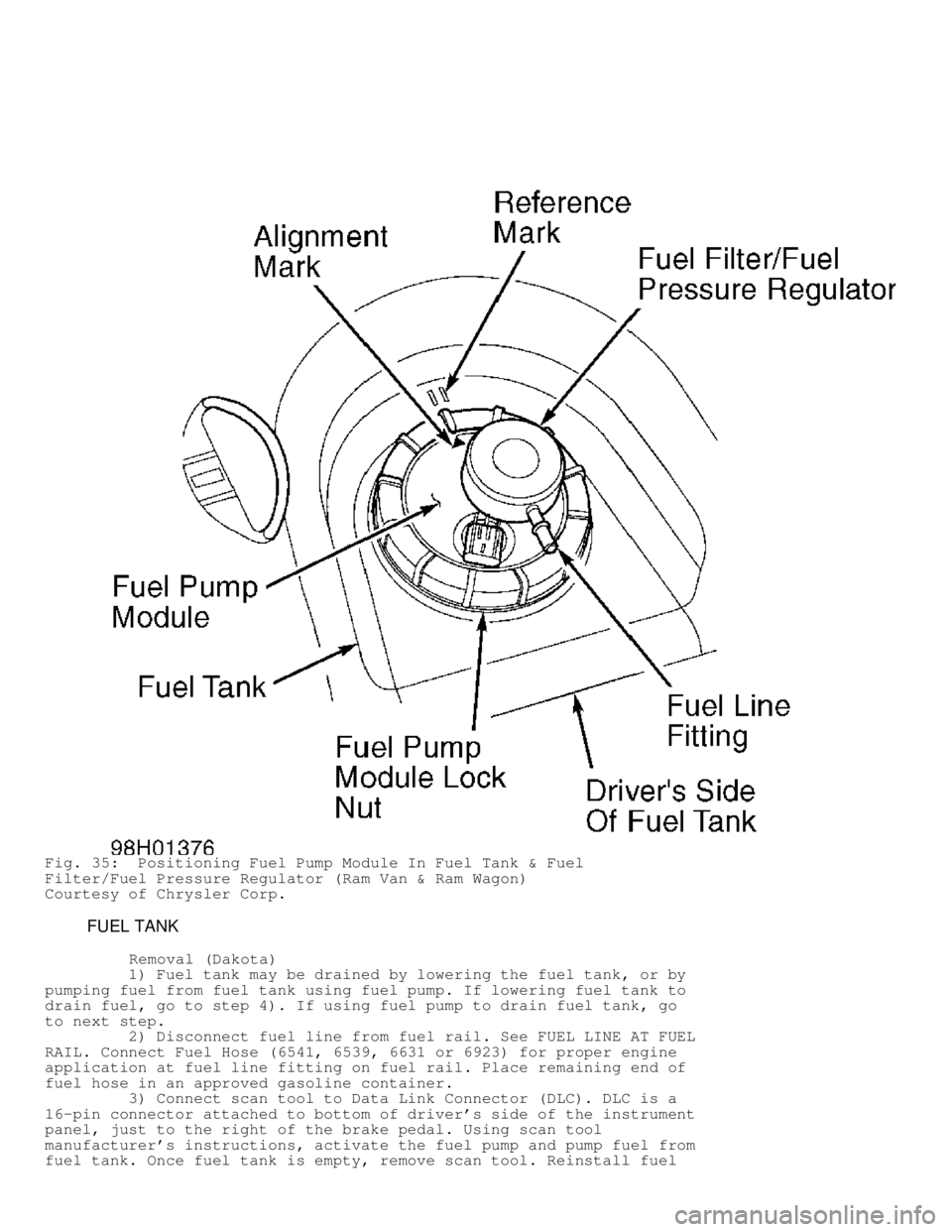
Fig. 35: Positioning Fuel Pump Module In Fuel Tank & Fuel
Filter/Fuel Pressure Regulator (Ram Van & Ram Wagon)
Courtesy of Chrysler Corp.
FUEL TANK
Removal (Dakota)
1) Fuel tank may be drained by lowering the fuel tank, or by
pumping fuel from fuel tank using fuel pump. If lowering fuel tank to
drain fuel, go to step 4). If using fuel pump to drain fuel tank, go
to next step.
2) Disconnect fuel line from fuel rail. See FUEL LINE AT FUEL
RAIL. Connect Fuel Hose (6541, 6539, 6631 or 6923) for proper engine
application at fuel line fitting on fuel rail. Place remaining end of
fuel hose in an approved gasoline container.
3) Connect scan tool to Data Link Connector (DLC). DLC is a
16-pin connector attached to bottom of driver's side of the instrument
panel, just to the right of the brake pedal. Using scan tool
manufacturer's instructions, activate the fuel pump and pump fuel from
fuel tank. Once fuel tank is empty, remove scan tool. Reinstall fuel
Page 985 of 1691
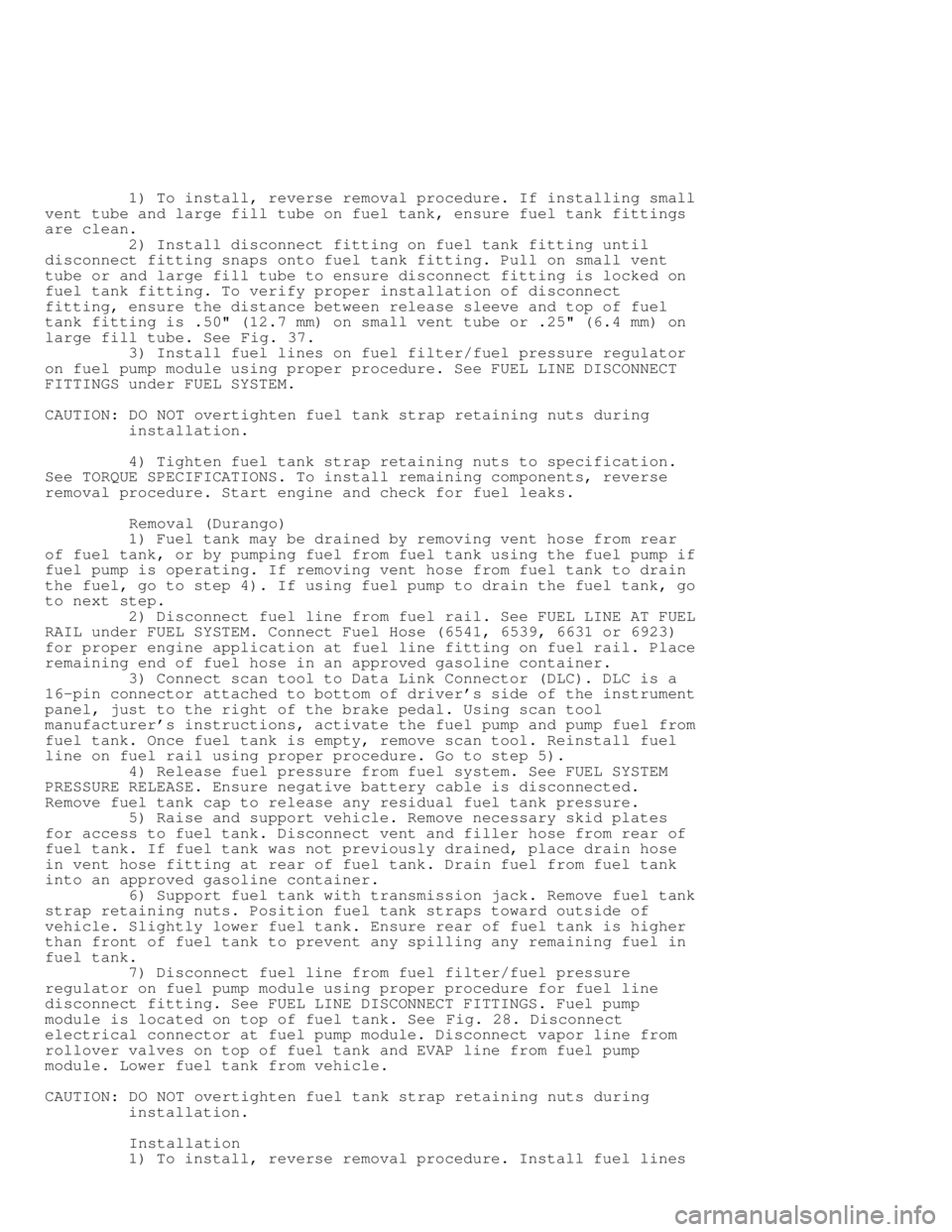
1) To install, reverse removal procedure. If installing small
vent tube and large fill tube on fuel tank, ensure fuel tank fittings
are clean.
2) Install disconnect fitting on fuel tank fitting until
disconnect fitting snaps onto fuel tank fitting. Pull on small vent
tube or and large fill tube to ensure disconnect fitting is locked on
fuel tank fitting. To verify proper installation of disconnect
fitting, ensure the distance between release sleeve and top of fuel
tank fitting is .50" (12.7 mm) on small vent tube or .25" (6.4 mm) o\
n
large fill tube. See Fig. 37.
3) Install fuel lines on fuel filter/fuel pressure regulator
on fuel pump module using proper procedure. See FUEL LINE DISCONNECT
FITTINGS under FUEL SYSTEM.
CAUTION: DO NOT overtighten fuel tank strap retaining nuts during
installation.
4) Tighten fuel tank strap retaining nuts to specification.
See TORQUE SPECIFICATIONS. To install remaining components, reverse
removal procedure. Start engine and check for fuel leaks.
Removal (Durango)
1) Fuel tank may be drained by removing vent hose from rear
of fuel tank, or by pumping fuel from fuel tank using the fuel pump if
fuel pump is operating. If removing vent hose from fuel tank to drain
the fuel, go to step 4). If using fuel pump to drain the fuel tank, go
to next step.
2) Disconnect fuel line from fuel rail. See FUEL LINE AT FUEL
RAIL under FUEL SYSTEM. Connect Fuel Hose (6541, 6539, 6631 or 6923)
for proper engine application at fuel line fitting on fuel rail. Place
remaining end of fuel hose in an approved gasoline container.
3) Connect scan tool to Data Link Connector (DLC). DLC is a
16-pin connector attached to bottom of driver's side of the instrument
panel, just to the right of the brake pedal. Using scan tool
manufacturer's instructions, activate the fuel pump and pump fuel from
fuel tank. Once fuel tank is empty, remove scan tool. Reinstall fuel
line on fuel rail using proper procedure. Go to step 5).
4) Release fuel pressure from fuel system. See FUEL SYSTEM
PRESSURE RELEASE. Ensure negative battery cable is disconnected.
Remove fuel tank cap to release any residual fuel tank pressure.
5) Raise and support vehicle. Remove necessary skid plates
for access to fuel tank. Disconnect vent and filler hose from rear of
fuel tank. If fuel tank was not previously drained, place drain hose
in vent hose fitting at rear of fuel tank. Drain fuel from fuel tank
into an approved gasoline container.
6) Support fuel tank with transmission jack. Remove fuel tank
strap retaining nuts. Position fuel tank straps toward outside of
vehicle. Slightly lower fuel tank. Ensure rear of fuel tank is higher
than front of fuel tank to prevent any spilling any remaining fuel in
fuel tank.
7) Disconnect fuel line from fuel filter/fuel pressure
regulator on fuel pump module using proper procedure for fuel line
disconnect fitting. See FUEL LINE DISCONNECT FITTINGS. Fuel pump
module is located on top of fuel tank. See Fig. 28. Disconnect
electrical connector at fuel pump module. Disconnect vapor line from
rollover valves on top of fuel tank and EVAP line from fuel pump
module. Lower fuel tank from vehicle.
CAUTION: DO NOT overtighten fuel tank strap retaining nuts during
installation.
Installation
1) To install, reverse removal procedure. Install fuel lines
Page 986 of 1691
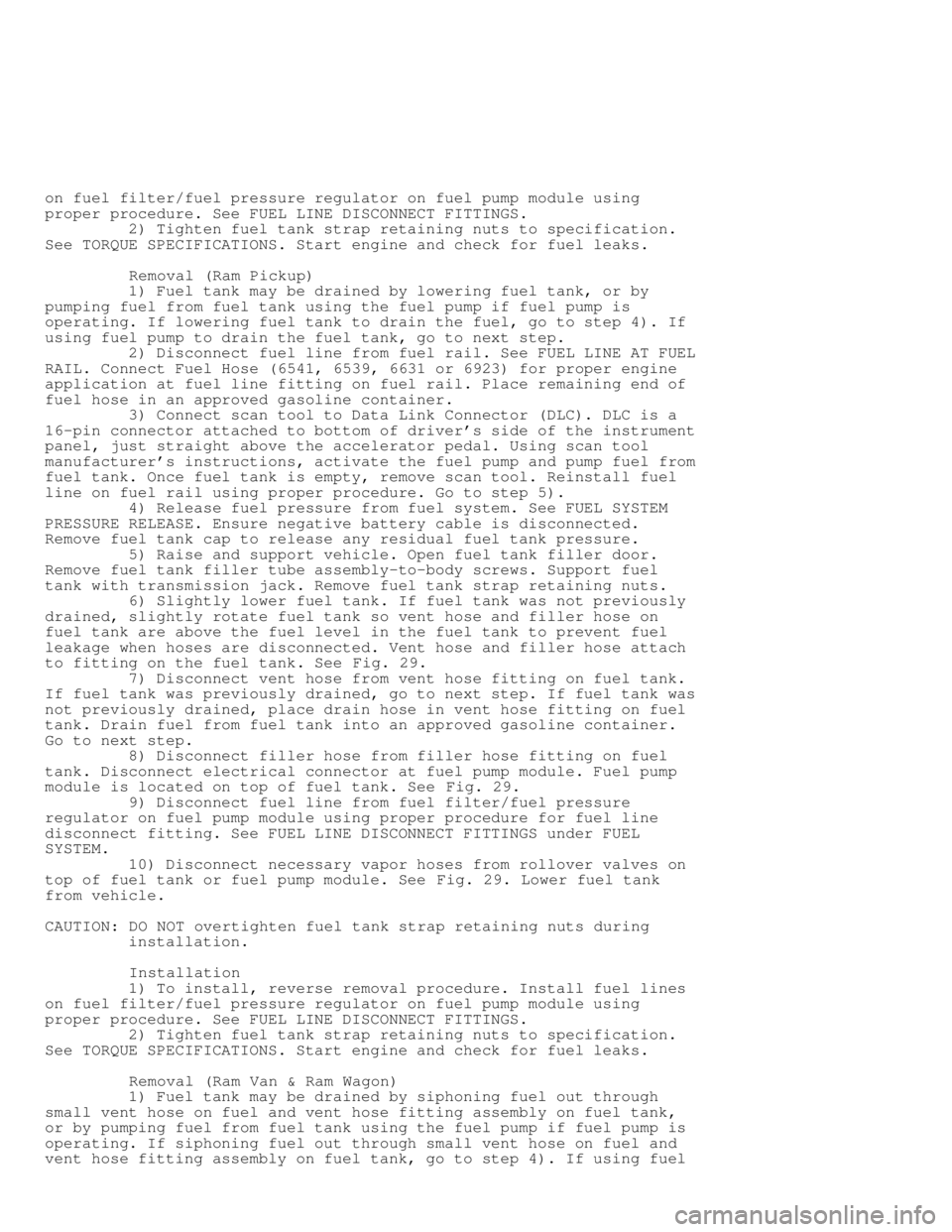
on fuel filter/fuel pressure regulator on fuel pump module using
proper procedure. See FUEL LINE DISCONNECT FITTINGS.
2) Tighten fuel tank strap retaining nuts to specification.
See TORQUE SPECIFICATIONS. Start engine and check for fuel leaks.
Removal (Ram Pickup)
1) Fuel tank may be drained by lowering fuel tank, or by
pumping fuel from fuel tank using the fuel pump if fuel pump is
operating. If lowering fuel tank to drain the fuel, go to step 4). If
using fuel pump to drain the fuel tank, go to next step.
2) Disconnect fuel line from fuel rail. See FUEL LINE AT FUEL
RAIL. Connect Fuel Hose (6541, 6539, 6631 or 6923) for proper engine
application at fuel line fitting on fuel rail. Place remaining end of
fuel hose in an approved gasoline container.
3) Connect scan tool to Data Link Connector (DLC). DLC is a
16-pin connector attached to bottom of driver's side of the instrument
panel, just straight above the accelerator pedal. Using scan tool
manufacturer's instructions, activate the fuel pump and pump fuel from
fuel tank. Once fuel tank is empty, remove scan tool. Reinstall fuel
line on fuel rail using proper procedure. Go to step 5).
4) Release fuel pressure from fuel system. See FUEL SYSTEM
PRESSURE RELEASE. Ensure negative battery cable is disconnected.
Remove fuel tank cap to release any residual fuel tank pressure.
5) Raise and support vehicle. Open fuel tank filler door.
Remove fuel tank filler tube assembly-to-body screws. Support fuel
tank with transmission jack. Remove fuel tank strap retaining nuts.
6) Slightly lower fuel tank. If fuel tank was not previously
drained, slightly rotate fuel tank so vent hose and filler hose on
fuel tank are above the fuel level in the fuel tank to prevent fuel
leakage when hoses are disconnected. Vent hose and filler hose attach
to fitting on the fuel tank. See Fig. 29.
7) Disconnect vent hose from vent hose fitting on fuel tank.
If fuel tank was previously drained, go to next step. If fuel tank was
not previously drained, place drain hose in vent hose fitting on fuel
tank. Drain fuel from fuel tank into an approved gasoline container.
Go to next step.
8) Disconnect filler hose from filler hose fitting on fuel
tank. Disconnect electrical connector at fuel pump module. Fuel pump
module is located on top of fuel tank. See Fig. 29.
9) Disconnect fuel line from fuel filter/fuel pressure
regulator on fuel pump module using proper procedure for fuel line
disconnect fitting. See FUEL LINE DISCONNECT FITTINGS under FUEL
SYSTEM.
10) Disconnect necessary vapor hoses from rollover valves on
top of fuel tank or fuel pump module. See Fig. 29. Lower fuel tank
from vehicle.
CAUTION: DO NOT overtighten fuel tank strap retaining nuts during
installation.
Installation
1) To install, reverse removal procedure. Install fuel lines
on fuel filter/fuel pressure regulator on fuel pump module using
proper procedure. See FUEL LINE DISCONNECT FITTINGS.
2) Tighten fuel tank strap retaining nuts to specification.
See TORQUE SPECIFICATIONS. Start engine and check for fuel leaks.
Removal (Ram Van & Ram Wagon)
1) Fuel tank may be drained by siphoning fuel out through
small vent hose on fuel and vent hose fitting assembly on fuel tank,
or by pumping fuel from fuel tank using the fuel pump if fuel pump is
operating. If siphoning fuel out through small vent hose on fuel and
vent hose fitting assembly on fuel tank, go to step 4). If using fuel
Page 987 of 1691
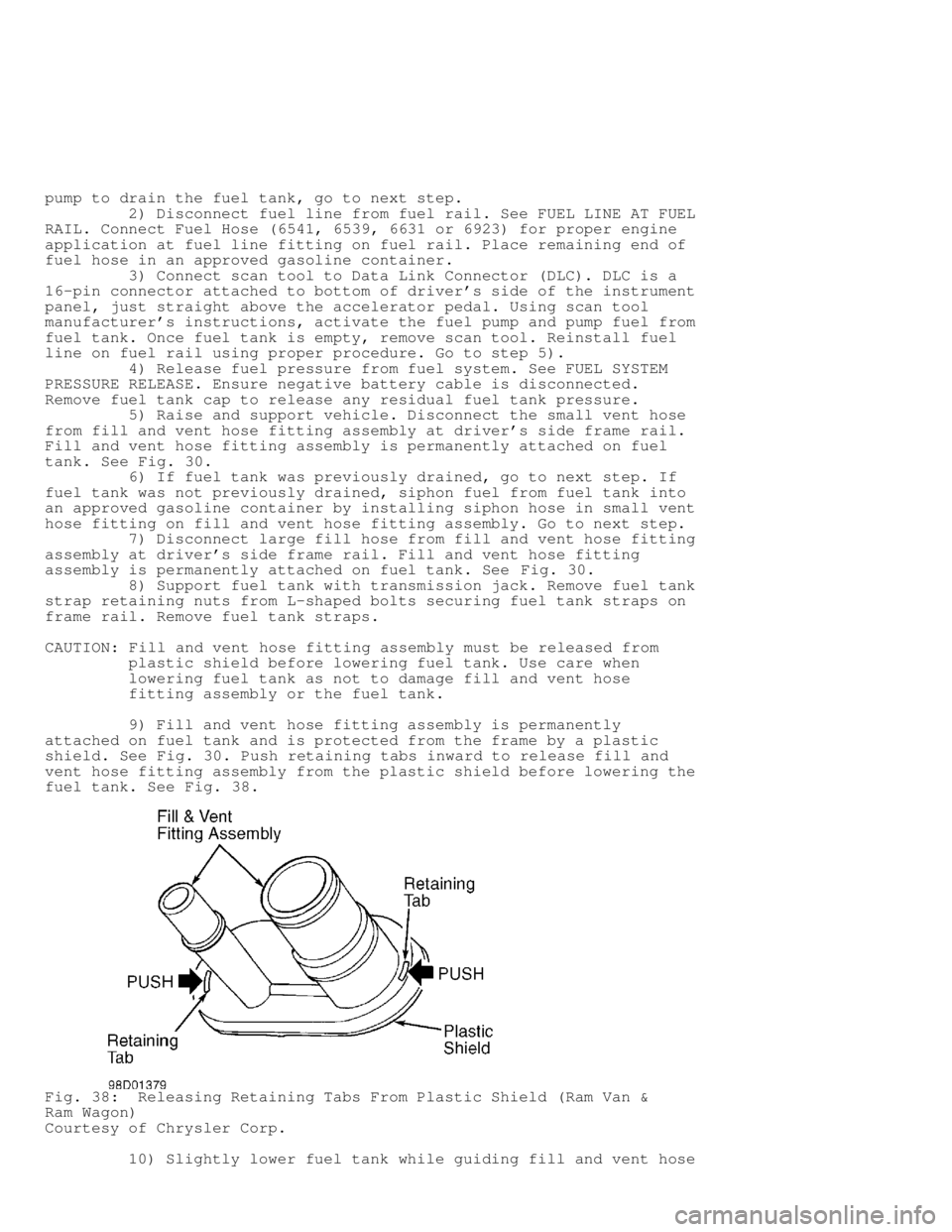
pump to drain the fuel tank, go to next step.
2) Disconnect fuel line from fuel rail. See FUEL LINE AT FUEL
RAIL. Connect Fuel Hose (6541, 6539, 6631 or 6923) for proper engine
application at fuel line fitting on fuel rail. Place remaining end of
fuel hose in an approved gasoline container.
3) Connect scan tool to Data Link Connector (DLC). DLC is a
16-pin connector attached to bottom of driver's side of the instrument
panel, just straight above the accelerator pedal. Using scan tool
manufacturer's instructions, activate the fuel pump and pump fuel from
fuel tank. Once fuel tank is empty, remove scan tool. Reinstall fuel
line on fuel rail using proper procedure. Go to step 5).
4) Release fuel pressure from fuel system. See FUEL SYSTEM
PRESSURE RELEASE. Ensure negative battery cable is disconnected.
Remove fuel tank cap to release any residual fuel tank pressure.
5) Raise and support vehicle. Disconnect the small vent hose
from fill and vent hose fitting assembly at driver's side frame rail.
Fill and vent hose fitting assembly is permanently attached on fuel
tank. See Fig. 30.
6) If fuel tank was previously drained, go to next step. If
fuel tank was not previously drained, siphon fuel from fuel tank into
an approved gasoline container by installing siphon hose in small vent
hose fitting on fill and vent hose fitting assembly. Go to next step.
7) Disconnect large fill hose from fill and vent hose fitting
assembly at driver's side frame rail. Fill and vent hose fitting
assembly is permanently attached on fuel tank. See Fig. 30.
8) Support fuel tank with transmission jack. Remove fuel tank
strap retaining nuts from L-shaped bolts securing fuel tank straps on
frame rail. Remove fuel tank straps.
CAUTION: Fill and vent hose fitting assembly must be released from
plastic shield before lowering fuel tank. Use care when
lowering fuel tank as not to damage fill and vent hose
fitting assembly or the fuel tank.
9) Fill and vent hose fitting assembly is permanently
attached on fuel tank and is protected from the frame by a plastic
shield. See Fig. 30. Push retaining tabs inward to release fill and
vent hose fitting assembly from the plastic shield before lowering the
fuel tank. See Fig. 38.
Fig. 38: Releasing Retaining Tabs From Plastic Shield (Ram Van &
Ram Wagon)
Courtesy of Chrysler Corp.
10) Slightly lower fuel tank while guiding fill and vent hose
Page 988 of 1691
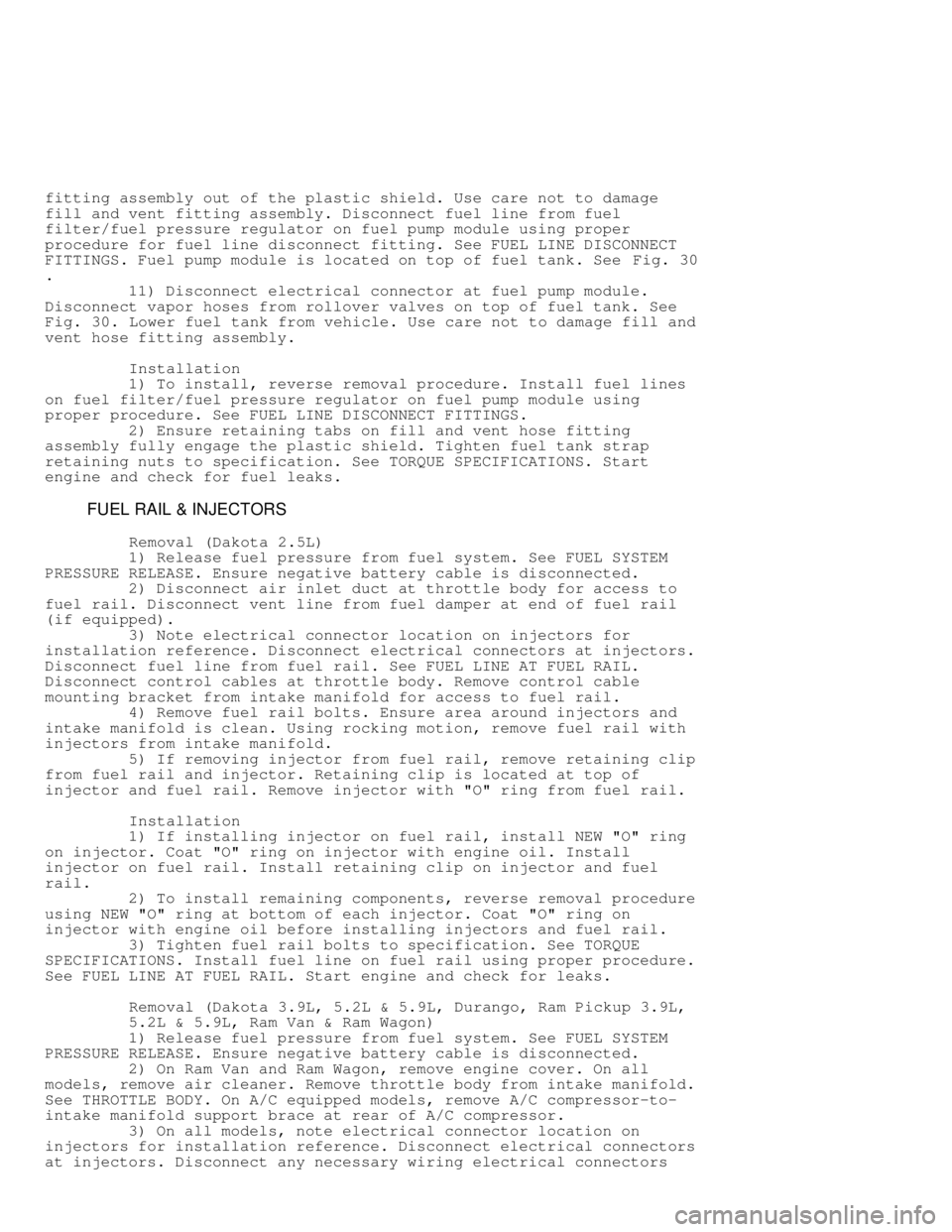
fitting assembly out of the plastic shield. Use care not to damage
fill and vent fitting assembly. Disconnect fuel line from fuel
filter/fuel pressure regulator on fuel pump module using proper
procedure for fuel line disconnect fitting. See FUEL LINE DISCONNECT
FITTINGS. Fuel pump module is located on top of fuel tank. See Fig. 30
.
11) Disconnect electrical connector at fuel pump module.
Disconnect vapor hoses from rollover valves on top of fuel tank. See
Fig. 30 . Lower fuel tank from vehicle. Use care not to damage fill and
vent hose fitting assembly.
Installation
1) To install, reverse removal procedure. Install fuel lines
on fuel filter/fuel pressure regulator on fuel pump module using
proper procedure. See FUEL LINE DISCONNECT FITTINGS.
2) Ensure retaining tabs on fill and vent hose fitting
assembly fully engage the plastic shield. Tighten fuel tank strap
retaining nuts to specification. See TORQUE SPECIFICATIONS. Start
engine and check for fuel leaks.
FUEL RAIL & INJECTORS
Removal (Dakota 2.5L)
1) Release fuel pressure from fuel system. See FUEL SYSTEM
PRESSURE RELEASE. Ensure negative battery cable is disconnected.
2) Disconnect air inlet duct at throttle body for access to
fuel rail. Disconnect vent line from fuel damper at end of fuel rail
(if equipped).
3) Note electrical connector location on injectors for
installation reference. Disconnect electrical connectors at injectors.
Disconnect fuel line from fuel rail. See FUEL LINE AT FUEL RAIL.
Disconnect control cables at throttle body. Remove control cable
mounting bracket from intake manifold for access to fuel rail.
4) Remove fuel rail bolts. Ensure area around injectors and
intake manifold is clean. Using rocking motion, remove fuel rail with
injectors from intake manifold.
5) If removing injector from fuel rail, remove retaining clip
from fuel rail and injector. Retaining clip is located at top of
injector and fuel rail. Remove injector with "O" ring from fuel rail.
Installation
1) If installing injector on fuel rail, install NEW "O" ring
on injector. Coat "O" ring on injector with engine oil. Install
injector on fuel rail. Install retaining clip on injector and fuel
rail.
2) To install remaining components, reverse removal procedure
using NEW "O" ring at bottom of each injector. Coat "O" ring on
injector with engine oil before installing injectors and fuel rail.
3) Tighten fuel rail bolts to specification. See TORQUE
SPECIFICATIONS. Install fuel line on fuel rail using proper procedure.
See FUEL LINE AT FUEL RAIL. Start engine and check for leaks.
Removal (Dakota 3.9L, 5.2L & 5.9L, Durango, Ram Pickup 3.9L,
5.2L & 5.9L, Ram Van & Ram Wagon)
1) Release fuel pressure from fuel system. See FUEL SYSTEM
PRESSURE RELEASE. Ensure negative battery cable is disconnected.
2) On Ram Van and Ram Wagon, remove engine cover. On all
models, remove air cleaner. Remove throttle body from intake manifold.
See THROTTLE BODY. On A/C equipped models, remove A/C compressor-to-
intake manifold support brace at rear of A/C compressor.
3) On all models, note electrical connector location on
injectors for installation reference. Disconnect electrical connectors
at injectors. Disconnect any necessary wiring electrical connectors
Page 989 of 1691
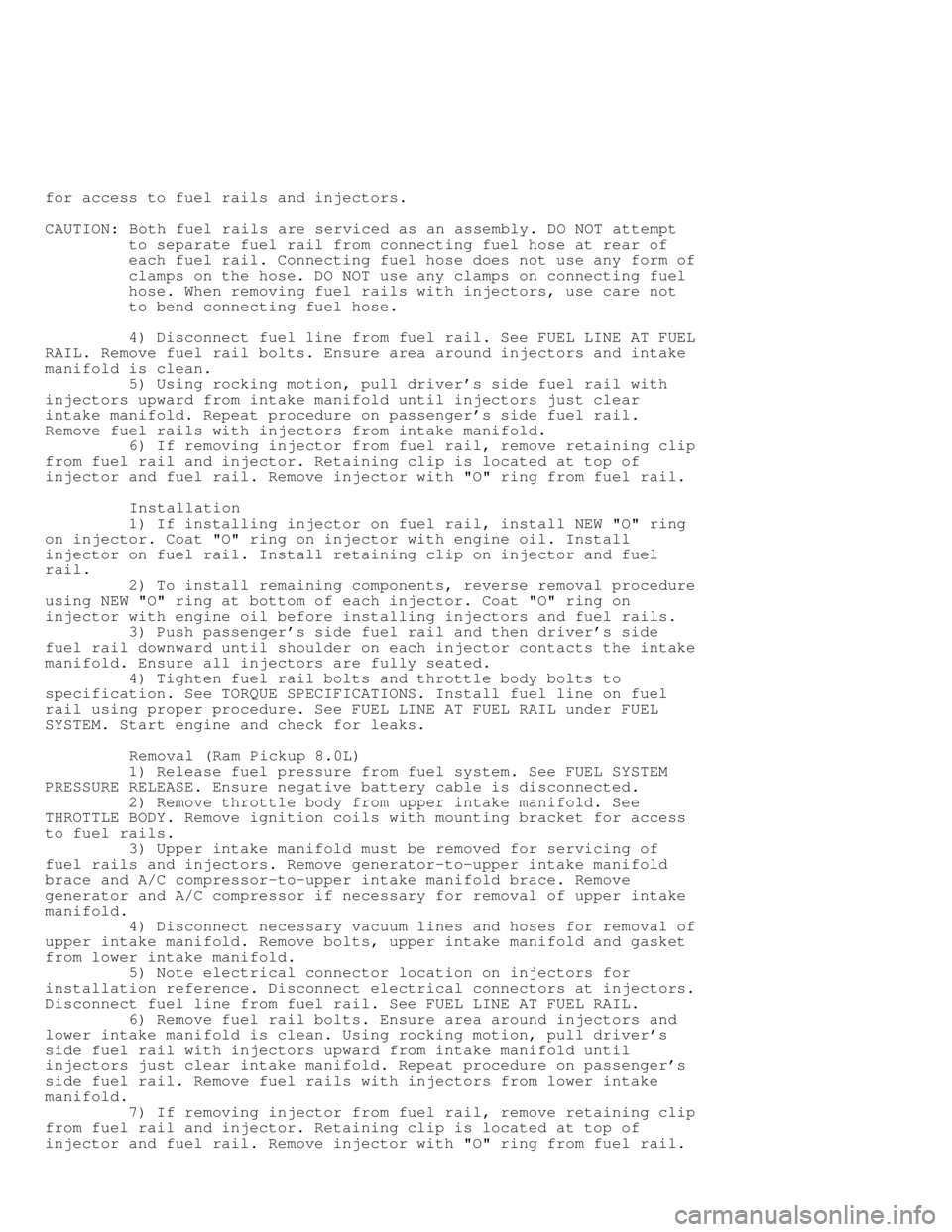
for access to fuel rails and injectors.
CAUTION: Both fuel rails are serviced as an assembly. DO NOT attempt
to separate fuel rail from connecting fuel hose at rear of
each fuel rail. Connecting fuel hose does not use any form of
clamps on the hose. DO NOT use any clamps on connecting fuel
hose. When removing fuel rails with injectors, use care not
to bend connecting fuel hose.
4) Disconnect fuel line from fuel rail. See FUEL LINE AT FUEL
RAIL. Remove fuel rail bolts. Ensure area around injectors and intake
manifold is clean.
5) Using rocking motion, pull driver's side fuel rail with
injectors upward from intake manifold until injectors just clear
intake manifold. Repeat procedure on passenger's side fuel rail.
Remove fuel rails with injectors from intake manifold.
6) If removing injector from fuel rail, remove retaining clip
from fuel rail and injector. Retaining clip is located at top of
injector and fuel rail. Remove injector with "O" ring from fuel rail.
Installation
1) If installing injector on fuel rail, install NEW "O" ring
on injector. Coat "O" ring on injector with engine oil. Install
injector on fuel rail. Install retaining clip on injector and fuel
rail.
2) To install remaining components, reverse removal procedure
using NEW "O" ring at bottom of each injector. Coat "O" ring on
injector with engine oil before installing injectors and fuel rails.
3) Push passenger's side fuel rail and then driver's side
fuel rail downward until shoulder on each injector contacts the intake
manifold. Ensure all injectors are fully seated.
4) Tighten fuel rail bolts and throttle body bolts to
specification. See TORQUE SPECIFICATIONS. Install fuel line on fuel
rail using proper procedure. See FUEL LINE AT FUEL RAIL under FUEL
SYSTEM. Start engine and check for leaks.
Removal (Ram Pickup 8.0L)
1) Release fuel pressure from fuel system. See FUEL SYSTEM
PRESSURE RELEASE. Ensure negative battery cable is disconnected.
2) Remove throttle body from upper intake manifold. See
THROTTLE BODY. Remove ignition coils with mounting bracket for access
to fuel rails.
3) Upper intake manifold must be removed for servicing of
fuel rails and injectors. Remove generator-to-upper intake manifold
brace and A/C compressor-to-upper intake manifold brace. Remove
generator and A/C compressor if necessary for removal of upper intake
manifold.
4) Disconnect necessary vacuum lines and hoses for removal of
upper intake manifold. Remove bolts, upper intake manifold and gasket
from lower intake manifold.
5) Note electrical connector location on injectors for
installation reference. Disconnect electrical connectors at injectors.
Disconnect fuel line from fuel rail. See FUEL LINE AT FUEL RAIL.
6) Remove fuel rail bolts. Ensure area around injectors and
lower intake manifold is clean. Using rocking motion, pull driver's
side fuel rail with injectors upward from intake manifold until
injectors just clear intake manifold. Repeat procedure on passenger's
side fuel rail. Remove fuel rails with injectors from lower intake
manifold.
7) If removing injector from fuel rail, remove retaining clip
from fuel rail and injector. Retaining clip is located at top of
injector and fuel rail. Remove injector with "O" ring from fuel rail.